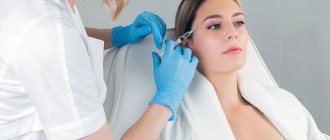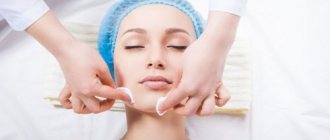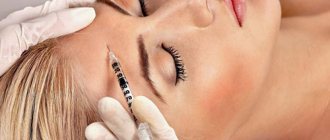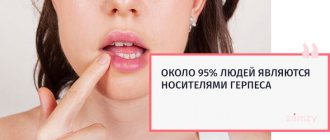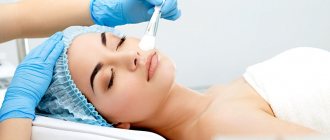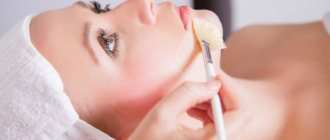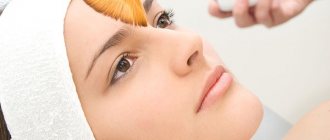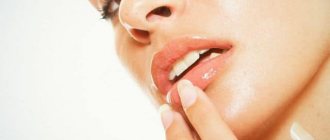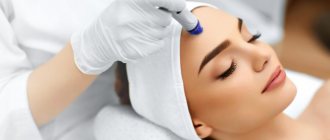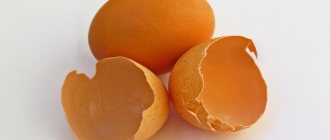Peeling is a mandatory procedure to maintain and preserve facial beauty. Its essence is to remove the top layer of dead cells and stimulate the growth of new ones. Chemical procedures are especially popular: they are much more effective than mechanical ones, and allow even those with delicate, thin skin to “renew their face.”
To get the perfect result, you need not only to properly prepare the skin and carry out the procedure, but also to know what restorative facial care should be like after peeling.
Three important rules for post-peeling care
The chemical or mechanical method of exfoliation affects the upper layer of the epidermis in the same way: the keratinized scales are peeled off, exposing a layer of young cells. Aggressive influence of the external environment is dangerous for them, so for the first three days you should take maximum care of your face. It is necessary to protect the skin from the following negative factors:
- natural solar ultraviolet;
- artificial UV rays;
- aggressive cosmetics;
- high or low temperature;
- adverse weather factors (snow, wind, rain).
That is why it is better to do any type of peeling in such a way as to reduce going outside to a minimum for two or three days. If it is not possible to take a day off and spend rehabilitation time at home, you need to protect your skin as much as possible: use hypoallergenic products with a UV protection effect, avoid exposing your skin to direct rays of the sun, and do not visit the sauna or bathhouse.
Types of chemical exposure
Facial care after mechanical and chemical peeling is slightly different. Chemical exfoliation procedures with various acids are a more gentle method of skin renewal, as they eliminate the risk of mechanical damage. Skin after acid exposure requires special care, which depends on the degree of penetration of the active substances. There are three types of chemical peels:
- surface;
- median;
- deep.
The latter type is equivalent to surgical intervention, is performed only in a hospital setting, and requires serious recovery.
Superficial acid exfoliation is carried out using fruit acids, such as ferulic acid, as well as weak mandelic, glycolic, and pyruvic acids. The median involves the use of retinoic acid or glycolic acid in a higher concentration. Facial skin care after chemical peeling differs in some significant features for each type of acid, although the general principles are similar.
Light chemical exfoliation: care features
After peeling with fruit acids, you should touch your face as little as possible, use a moisturizing gel or serum on the advice of a cosmetologist, and completely exclude tonics and lotions from your care. Care cosmetics after peeling with fruit acids should be hypoallergenic and have a light, airy foam or gel consistency. You should forget about scrubs for five days: damage to the skin after superficial peeling can cause serious problems.
Sometimes a cosmetologist may advise you to stop using eye care products, day and night creams for a few days. However, this is not a mandatory rule. So, after ferul peeling, which is the most gentle and safe, you can return to your usual skincare regimen the next day. For comparison, facial care after glycolic peeling is more strict and limits the use of usual cosmetics for the first three days.
Restoring dry skin after almond exfoliation requires active moisturizing, using products with hyaluronic acid, collagen, seaweed extract, shea butter, and aloe juice. You can combine care after superficial peeling with a course of vitamins E and C.
Facial care after a glycolic peel consists of using high-filter sunscreen for three days. At this moment, usual care products are either not used or are replaced with special restorative products on the recommendation of a cosmetologist.
Medium peeling: features of rehabilitation
Medium exfoliation allows you to work with deeper layers of skin. Recovery in this case requires more time for rehabilitation. After a retinoic peel, the skin may turn yellow.
After retinoic peeling, you should not deliberately accelerate skin exfoliation. The only help may be constant hydration. The use of bactericidal masks has good results. If swelling occurs after retinoic exfoliation, irrigation with homemade melt water or products with deuterium water will help relieve it. For two weeks, you should not use cosmetics with AHA-acyls or retinoids, perm or dye your hair.
Care after yellow peeling should include masks containing lactic acid, cranberry enzymes, as well as balms with anti-inflammatory and regenerating components (low shea, panthenol, fireweed extract, etc.).
Mechanical exfoliation
Effective exfoliation is also achieved by mechanical peelings, for example, bodyaga or coral chips. They belong to biological procedures, as natural materials are used to exfoliate the epidermis.
After bodyagi-based exfoliation, there is no need to apply cosmetics to the face. You can wipe the skin with a cube of frozen soothing infusion or clean water. As soon as the face begins to peel, that is, on the second or third day, you can begin massages using a rich cream or heated olive oil. You can complete the procedure with a softening mask. The exfoliation process cannot be stimulated. It is only allowed to wipe the face with a clean, coarse cloth soaked in hot water.
Exfoliation with coral chips may cause redness and skin rashes, which is considered a normal reaction. After coral exfoliation, the face should be treated with a weak vinegar solution, followed by applying a moisturizer. Once exfoliation has begun, the vinegar treatment should be stopped. It is better to wash your face with clean water and apply moisturizer to your face. You can return to your usual care regimen after coral exposure on the fourth or fifth day, when the process is completed.
Additional recovery
It is impossible to predict an individual reaction to one or another type of exfoliation in advance. Mild chemical exfoliation treatments rarely cause complications requiring additional care treatments. As a rule, on the third day there is no trace of any external influence.
However, swelling, changes in complexion, and the appearance of atypical skin reactions require additional rehabilitation measures. In some cases, the cosmetologist prescribes antihistamines and changes the recommended restorative agents.
Care after peeling does not cause any difficulties, at most some inconvenience. Anti-inflammatory agents with antioxidants may be required to prevent hyperpigmentation, infection and promote skin regeneration.
With age, the synthesis of glycosaminoglycans in the body slows down, so for the sake of smooth and beautiful skin, many girls resort to hyaluronic acid injections. But not everyone knows that there is a much more pleasant alternative - hyaluronic peeling.
Hyaluronic cleansing not only saturates the cells with moisture, but also tightens the oval of the face and evens out the shade. At the same time, the session is more reminiscent of a SPA than a clinic. This is because hyaluronate peeling does not cause any pain or even minimal burning.
The method itself belongs to the category of superficial. Like other similar treatments, hyaluronic exfoliants soften and slough away dead cells.
The desquamation of dead horny scales of the epidermis lasts for 2 weeks
, so the skin is renewed delicately.
Refreshed and rejuvenated epidermis ultimately looks more attractive and better absorbs water, oxygen and cosmeceuticals.
WHAT IS HYALURON FACIAL PEELING
Glycosaminoglycans are valued in cosmetology due to their special chemical properties. When they break down, they release large amounts of water, which is why they have gained popularity as an effective moisturizer.
Good skin hydration helps smooth out the network of fine wrinkles and thickens the epidermis, which helps retain moisture from the inside. There are practically no complications or allergic reactions after hyaluronic exfoliation.
Hyaluronic exfoliants transport active components deep into the skin due to their low molecular structure. At the same time, a thin breathable film is formed on the surface of the face, which prevents moisture loss and harmful atmospheric influences.
Hyaluronic cleansing is called “all-season” and sometimes even “summer”
, but it is still better to carry it out in cloudy seasons.
Operating principle
Scientists discovered hyaluronic exfoliants about 100 years ago, and in the modern world the artificial synthesis of this active substance has already been mastered. Synthetic hyaluronic acid (HA) even surpasses the original in its hypoallergenic and antibacterial parameters.
Main functions of hyaluronate:
- Binds water molecules and prevents their volatilization;
- Protects against bacteria and infections;
- Speeds up metabolism;
- Clears toxins, binds free radicals ().
The result is firmer skin with a healthy glow.
In the human body, the substance is present in the joints, cartilage or vitreous part of the eye.
In medicine, it is used to treat relevant tissues (for example, osteoarthritis or cataracts). There are scientific studies on the effectiveness of HA in the fight against cancer.
Indications for the procedure
Indications for peeling with hyaluronic acid:
- Any skin type;
- Dehydration;
- A network of wrinkles;
- Photoaging;
- Enlarged pores;
- Seborrhea;
Contraindications and precautions
The hyaluronic exfoliation technique is quite safe, but in some cases it is worth canceling the session:
- If the skin is damaged, there are open wounds;
- If the infection has worsened (herpes, smallpox, etc.);
- Against the background of weakened immunity;
- and nursing;
- At the height of the beach season;
- If you are allergic to the components of the product;
- For rosacea (additional consultation with a specialist is required).
COMPOUND
Deionized Water, Azelogermanium tm (20%) conjugated with hyaluronic acid Deionized artesian water, azelogermanium (azelaic acid and organic germanium) conjugated with hyaluronic acid
Irina Evdokimova (cosmetologist) September 06, 2018
Comment: I use it in any peeling from the Azelo/Lacto programs) , before meso, if anesthesia is not required. Apply a thin layer with a light massage until dry. I keep it for up to 15 minutes. Mild hyperemia is possible on very thin, dry, sensitive skin. There is no visible exfoliation. Very good results for acne and post-acne. I didn’t use it with bright acne, because there are no such patients. ) I have more older ladies. But I do it for my children with comedones and certain inflammatory elements) It dries well
Victoria
April 17, 2017
The effect is the same as after mesotherapy
Comment: In combination with delicate peeling and two masks (one in a tube + on a fabric basis), after about 4-5 procedures, the final effect is like after mesotherapy... the skin is so moisturized that it visually looks as if hyaluronic acid was applied. These peelings with masks are an excellent alternative for those who, for various reasons, do not undergo mesotherapy and biorevitalization. But for a more prolonged effect, it is necessary to prescribe a fabric mask to the client at home in a course. If you carry out a full course of delicate peeling with masks, and prescribe cosmetics to the client’s home, especially a large package of hyaluronic mask, I think that this is an excellent replacement for mesotherapy (after all, not everyone can give injections) ... and in the end everything is very affordable, unlike from meso. But this is exactly after peelings. Azelo-germanium is more suitable for oily skin, which is less dehydrated, so results are also quickly noticeable, and at the same time other problems are solved, such as hyperpigmentation, enlarged pores, hyperkeratosis. Unlike just meso, these latter problems are usually less solved by introducing just meso with hyaluronic acid.
HYALURON PEELING IN THE BEAUTY SALON
1 week BEFORE
peeling with hyaluronic acid is recommended to prepare the skin of the face. To do this, we exfoliate dead cells using lotions with a weak fruit content. You can also additionally use hyaluronic care cosmetics.
Procedure protocol step by step:
- Cleansing and degreasing the skin.
- Apply peeling for up to 30 minutes. (Initial sessions require a careful approach and minimal exposure.)
- We neutralize the effect of the hyaluronic reagent with an alkali solution. A slight tingling sensation may be felt.
- Apply a nourishing mask.
- We create a protective barrier using UV cream.
The course usually includes 3-10 sessions.
Price for 1 treatment in the salon: from 15 €.
The pricing policy is influenced by the cost of basic hyaluronic preparations, as well as the qualifications of the cosmetologist and the general level of the salon.
Price of facial peeling with hyaluronic acid. How much does hyaluronic peeling cost?
It is best to entrust hyaluronic acid peeling to a professional. An experienced cosmetologist will take into account the condition of the skin, select the correct concentration of the working composition, and give the necessary recommendations. Typically, 3-10 sessions of hyaluronic cleansing are performed (one procedure every 7-10 days). The price of hyaluronic facial peeling in the salon (one session) is from 700 rubles . The cost of the procedure depends on what drug the cosmetologist uses, the qualifications of the specialist himself and the level of the clinic.
Hyaluronic peeling can also be carried out at home, using ready-made cosmetic compositions for the procedure. The cleansing course will take about three months, provided that one procedure is performed every one to two weeks.
BIOREVITALIZATION WITH HYALURONIC ACID
“BIOREVITALIZATION” means the correction of aesthetic imperfections in appearance with hyaluronic acid in a broad sense,
be it by injection or other means, to create “natural hydration”.
The role of hyaluronic exfoliants in preserving youth is known to many girls. However, we should not forget that preparations based on such components are not a panacea, and for a pronounced effect it is necessary to take comprehensive care of your face.
Cosmetologist Tiina Orasmäe-Meder:
“BIOREVITALIZATION IS USELESS!”
“The same 15 g of dry hyaluronic acid circulates in the body of a healthy young woman until the age of 60, so biorevitalization until then is, by and large, meaningless.
The condition of the skin can worsen at any age if you do not make sure that a sufficient amount of water (2 liters) enters the body daily and that its molecules do not evaporate due to poor barrier functions
.
Biorevitalization procedure with hyaluronic acid
This technique is very suitable for patients with pronounced signs of skin aging. Biorevitalization is prescribed after peeling; this promotes better and faster absorption of hyaluronic acid.
Molecules of hyaluronic acid are introduced into the epidermal and dermal layers with thin needles, which completely promotes rejuvenation and long-term hydration of the skin, wrinkles smooth out and become less noticeable. It’s great to do this procedure as a preventive measure against wrinkle formation.
HOME USE
It is also possible to use hyaluronic exfoliants at home. In this case, the whole course fits into 1 quarter (sessions are held 2-4 times a month).
Low-molecular-weight peeling preparations have proven themselves to be the best among glycosaminoglycan-based care products. Particles of such peelings easily penetrate the pores. They are made on the basis of hyaluronate in powder or ampoules.
Peeling with hyaluronic acid usually follows the same principle as in the salon: first, the face is washed with a special exfoliating lotion, and then the main cosmeceutical product is applied.
The algorithm of actions at home is as follows:
- An allergy test is performed on an inconspicuous area of skin.
- The face is degreased with alcohol-free lotion.
- A hyaluronic solution is prepared: a special powder is mixed with water until a gel consistency is obtained.
- The resulting mixture is applied for 30 minutes.
- Neutralized with alkali.
- The face is treated with saline solution to normalize the water-lipid layer.
- Sunscreen is applied.
Additional serum may be applied if necessary.
Within 1 week
It is prohibited to sunbathe under the sun or in a solarium, or to visit a SPA.
Moisturizing with low-fat creams is not prohibited.
Cosmetics during the regeneration period must contain UV filters.
In addition, the composition of care products certainly includes glycosaminoglycans, and dietary supplements based on glycosaminoglycans are sometimes recommended.
Hyaluronic acid after peeling is used to soften and moisturize the epidermis, as well as to prevent fine-plate peeling.
Properties of hyaluronic acid
Peeling with hyaluronic acid is an effective and gentle chemical skin cleanser. Hyaluronic acid is an integral part of our body, responsible for the interaction of water in the cells of the epidermis. The peeling contains acid of synthetic origin, but its properties are not inferior to natural ones. Thanks to the acid:
- retaining moisture in cells and preventing excessive evaporation of water;
- activation of the cell restoration process;
- prevention of the development of pathogenic bacteria and infections;
- restoration of cellular metabolism;
- removing toxins and free radicals from the skin.
Peeling promotes the formation of a thin protective layer that protects facial skin from adverse environmental factors.
Hyaluronic peels are carried out both in the salon and at home.
The procedure is performed in the following order:
- Preparation consists of cleansing the face with alcohol-free tonic, water or a special lotion; it is important to get rid of excess dirt and oil.
- First, a solution is prepared: water is added to the hyaluronic powder, the components are thoroughly mixed. The result is a gel mass.
- The consistency is applied to the skin of the face and décolleté. Then they wait thirty minutes: during this time, the active substances have time to penetrate deeply into the skin.
- To remove the mask, use an alkaline solution, which neutralizes the effect of acid.
- The water balance of the epidermis is restored using saline solution.
- The procedure is completed by applying an ultraviolet protective cream to the face.
If necessary, after the procedure, use soothing masks or serums based on your skin type.
In a beauty salon, the procedure is carried out from three to ten times, at home - from eight to twelve times. The peeling course takes approximately three months.
The undoubted positive aspect of the procedure is the absence of pain and burning. The upper layer of the epidermis is cleansed gradually, while the skin does not itch or flake. Cleansing comes unnoticed.
Pros and cons of hyaluronic acid peeling
Firstly, you should understand that hyaluronic peeling is much more gentle than chemical or mechanical peeling. Moreover, specialists often perform a superficial facial cleansing before applying hyaluronic acid.
You also don’t need to be scared by the very definition of “acid”, because the hyaluronic product does not contain any harmful substances. That is why cleansing with its help is recommended for almost everyone (with the exception of individual intolerance), since in essence we are using a product that is already contained in our body. Cases of allergies to hyaluronic acid are extremely rare.
It is also important to remember that any procedures must be carried out during periods of low solar activity. Otherwise, there is a risk of getting burned.
Indications for the procedure:
- Unhealthy complexion.
- Dry skin.
- The appearance of areas of skin peeling.
- Prevention of signs of aging (dark circles under the eyes, wrinkles, enlarged pores).
- Presence of traces of acne.
Hyaluronic acid is gentle on the skin, but if your skin is damaged, infected, has a fresh rash, or is hypersensitive, it is strongly recommended that you avoid the procedure. Peeling should not be performed on pregnant or breastfeeding women, or if they have a fever or other symptoms of a viral disease.
Contraindications for peeling with hyaluronic acid
1. Inflamed elements on the treated surface;
2. Pregnant and breastfeeding women should also not undergo this procedure;
3. Viral infections, herpetic rashes;
4. Thrombophilia and hemophilia;
5. Predisposition to scarring.
If hyaluronic acid was produced through biosynthesis, then there is a risk of bacterial waste products being introduced into the skin, which can cause the formation of acne, swelling and pain.
It should also be noted that an allergy may occur to hyaluronic acid if it was preceded by any type of aggressive peeling.
Stages of hyaluronic peeling
- Pre-cleansing of the skin. Despite the fact that peeling itself is a method of cleansing, the surface of the skin must be prepared for exposure. In particular, remove any remaining grease and dirt particles. To do this, use alcohol-free tonics, herbal infusions or a special lotion.
- The preparation is evenly applied to the prepared skin, affecting areas on the face, neck and décolleté. The consistency of the prepared hyaluronic acid resembles a gel or sour cream of medium fat content. The holding time is half an hour.
- In beauty salons, auxiliary ingredients are often added to the composition. Attention! Be sure to ask the specialist about which components will come into contact with your skin. Hyaluronic acid in its pure form (otherwise called stabilized) is practically harmless, but some additives can lead to adverse consequences (allergic reactions, acne).
- Hyaluronic acid is removed using a special solution. If the client wishes, the result can be secured by applying a nourishing mask.
- For several days after the procedure, it is recommended to use cosmetics with an increased degree of protection against ultraviolet rays.
It is noted that when exposed to hyaluronic acid there is no pain, burning or tingling. The procedures should not be carried out one-time, but as a full course. As a rule, it includes 4-10 sessions, with breaks between them ranging from 7 to 14 days. After completing a full course, it is recommended to take a break. It is not necessary to specially prepare the skin for the procedure.
Hyaluronic peeling at home
Unlike complex and traumatic chemical peels, cleansing with hyaluronic acid can be done at home without the risk of harming the skin. In this case, there are two options for using the substance: either use a ready-made composition from cosmetic companies, or resort to folk remedies. Let's consider both methods.
In the first case, the cosmetic product is usually a thick gel.
- Before applying it to your face, you need to clean and degrease your skin with tonic or micellar water, then dry thoroughly.
- The composition is applied with gentle movements, not too much, but so as to cover the entire skin surface. There should be no unpleasant sensations, but a slight tickling is possible - it is caused by bubbles that begin to burst upon contact with the skin.
- Once all the bubbles have dissolved, the composition can be washed off. It is better to do this with warm mineral water.
- After peeling, it is recommended to moisturize your face generously with a nourishing cream.
If you want to extract hyaluronic acid yourself, then ordinary chicken eggs can serve as assistants in this matter.
- 3-4 eggs must be thoroughly washed and then the internal contents removed - we only need the shell.
- It must be crushed into fine crumbs and simmered over low heat for about 12 hours. It is better to use mineral or at least filtered water.
- Initially, take a glass somewhere, and then add it as needed so that the composition does not thicken.
- You can use the decoction in several ways: wipe your face daily, exfoliating dead skin cells, or make a compress once a week, leaving it on your face for about 15 minutes.
In conclusion, I would like to note that peeling with hyaluronic acid is the least traumatic and affordable remedy in the fight against skin aging. Since exfoliation of the upper damaged layer occurs gently and carefully, no redness or rashes are observed. This is great for working women, since after a chemical peel you can miss out on life for a day or two, or even a week. In addition, the skin is not only actively moisturized, but also covered with a thin, invisible film that provides additional protection from the harmful effects of external factors.
The two-component peeling scrub is a unique patented cosmetic product. It is a paired sachet, where the contents of the first sachet are a solution of hyaluronic acid of various molecular weights in a total concentration of 1.8%, the second sachet is elastic polymer granules that provide soft exfoliation, improve blood circulation and promote the mechanical “driving” of hyaluronic acid into the skin. The product is not photosensitizing and can be used at any time of the year. The peeling procedure is comfortable even for sensitive skin. Suitable for use even in the area around the eyes. There is an immediate straightening of fine wrinkles, improvement in skin color and microrelief. The product is used to prepare for the application of active G-DERM products, or as an independent express care procedure.
Hyaluronic peeling scrub two-component G-DERM application:
1.The second stage of professional procedures, as preparation for the use of active G-DERM products 2.Independent procedure for express skin care with signs of aging Peeling is prepared immediately before the procedure. Remove the contents of sachet 1 into a glass cup, add the required amount of abrasive (sachet 2), mix until a homogeneous mass of turquoise color is obtained. For sensitive thin skin, it is recommended to use no more than half the contents of the sachet with polymer crystal. The finished peeling is applied to the skin of the face, neck and décolleté, exfoliate for 3 - 4 minutes with massage movements, until the hyaluronic acid is completely absorbed. Thoroughly rinse off any remaining peeling abrasive from the skin surface with a damp cloth or sponge.
Peeling or exfoliation is the procedure for removing the top layer of epithelium in order to expose healthy young cells and start metabolism. The epidermis consists of five layers that are continuously renewed. Normally, dead scales gradually peel off. But at a more mature age, natural processes slow down, which is why unexfoliated cells remain on the surface for a long time.
This affects the condition of the skin in the most negative way:
- disrupts update functions;
- interferes with cellular respiration of tissues;
- prevents the penetration of beneficial substances contained in care products (cream, serum, mask).
Together with old particles, biological pathogens - infectious microorganisms - are removed from the depths of the skin. Accumulated bacteria, viruses and other pathogenic flora provoke the occurrence of comedones, inflammation, acne, seborrhea, and vascular network. All these factors adversely affect the overall condition of the skin, triggering its premature aging.
Peeling not only gets rid of impurities and dead epidermis, but also activates tissue metabolic processes, increases cell regeneration, collagen and elastin synthesis, restoring youth and elasticity. After the procedure, the cells’ ability to absorb moisture and beneficial microelements and become saturated with oxygen improves. Pores are narrowed, pigment spots and redness are lightened, scars disappear, wrinkles are smoothed out.
If you regularly exfoliate at home, your skin will always look well-groomed, smooth and healthy. Try fruit peeling from the pulp of 1 kiwi, 1.5 tsp. semolina and a few drops of any oil (avocado, jojoba, wheat germ, olive). Mix all ingredients in a blender and massage onto face and neck. After 15 minutes, rinse with warm water and lubricate the skin with nourishing cream.
In a specialized clinic, a cosmetologist can offer several types of procedures depending on the depth of impact on the skin:
- mild superficial peeling with enzymes and enzymes contained in plants;
- surface – with alpha hydroxy acids;
- median - using trichloroacetic, glycolic, salicylic and other aggressive acids;
- deep - laser or phenolic acid based.
Separately, mechanical peeling should be highlighted - microdermabrasion or grinding using special equipment with microcrystals, and brossage (polishing with soft brushes).
Biorevitalization to saturate the dermis with moisture
Biorevitalization is based on injection or laser (hardware) delivery of hyaluronic acid gel into the deep layers of the skin. By interacting with cells and tissue receptors, the synthetic drug stimulates the production of its own hyaluronic acid. The substance collects and retains water molecules, increases the production of collagen and elastin fibers, which are responsible for tissue elasticity.
Hyaluronic acid is a viscous substance found in almost all biological fluids and tissues of the body. It is synthesized and broken down daily, playing a major role in cell hydrodynamics. But with age, the production of the substance slows down, and the rate of decay increases. As a result, the skin becomes dehydrated, peels, becomes thinner, and becomes wrinkled.
Thanks to the artificial delivery of hyaluronic acid directly into the skin, it is possible not only to prolong youth. The procedure allows you to correct existing signs of age in mature women. Biorevitalization is also indicated for girls with dry, thin and dull skin. To achieve a noticeable result, you will need to undergo the entire biorevitalization course of several procedures with rest intervals of 2–3 weeks. The number of sessions is selected taking into account the individual skin condition. And since hyaluronic acid is gradually eliminated from the body, maintenance procedures must be repeated periodically.
The substance is evenly distributed in problem areas using injections using certain techniques (point by point, papules, picotage, linear, etc.). For girls who are terrified of injections, there is a hardware method of biorevitalization. It consists of exposing tissue to a “cold” laser, as a result of which the pores open and the intercellular space expands. At the same time, the skin does not heat up, which eliminates the risk of burns. The gel is applied directly to the surface, from where it is absorbed into the deeper layers through transport channels.
Peeling or biorevitalization: which is better?
There is no answer to the question which procedure is better. Each procedure is aimed at solving specific problems. Peeling cleanses the skin, stimulates the growth of new cells by healing damaged epithelium, and ensures tissue respiration. Biorevitalization provides additional hydration to aging skin and triggers regeneration.
The best results can be achieved using a combined approach, the essence of which is combining exfoliation and biorevitalization with hyaluronic acid. This is the only way to restore epithelial tissues in a comprehensive manner – outside and inside.
Now let's find out whether it is possible to do peeling after biorevitalization and vice versa, whether it is allowed to combine methods at the same time.
Possible combinations of peeling and biorevitalization procedures
Only one method is rarely used to solve aesthetic problems. Typically, a specialist evaluates age-related changes and skin imperfections, and then prescribes an individual therapeutic or preventive course. To achieve a good result, they combine hardware and injection techniques, alternate peeling with biorevitalization. Both methods of rejuvenation are stimulating, so skillfully complementing one with the other allows you to increase efficiency several times.
There are two types of combination of procedures:
- Peeling after biorevitalization.
- Biorevitalization after peeling.
But both procedures are not carried out at the same time. This is due to the fact that any violation of the integrity of the integument is an absolute contraindication for injections, laser exposure, and the application of keratolytic substances (acids).
Biorevitalization before peeling
The procedure prepares the skin for aggressive effects, facilitates subsequent regeneration, reduces recovery time and reduces the risk of adverse reactions. This method not only accelerates the healing of damaged tissue, but also directs it in the right direction, creating an optimal physiological environment for cell activation.
Preliminary biorevitalization is relevant in the presence of bad habits, unbalanced nutrition, and unfavorable climatic conditions. The procedure reduces the negative impact of harmful factors on subsequent tissue restoration. Biorevitalization is absolutely necessary before medium or deep peeling, including laser resurfacing. It is also justified in women with serious age-related changes - severe ptosis, deep wrinkles, dryness, thinness, increased sensitivity of the epithelium, hyperpigmentation. With a minimum number of procedures, it is possible to obtain the maximum rejuvenation effect if peeling is performed after biorevitalization.
How long will it take?
In the absence of complications from biorevitalization, peeling is allowed to begin no earlier than 10–20 days after the end of the course of injections. The exact period depends on the type of drug administered (ordinary hyaluronic acid or ether). A prerequisite is clean, healthy skin without bruises or inflamed areas. Despite the fact that all the negative effects of biorevitalization disappear after 3–4 days, the body must undergo complete adaptation. Therefore, premature exposure to aggressive substances can harm the skin.
Peeling as preparation for biorevitalization
Peeling before biorevitalization is allowed to be done only after complete healing of the epidermis. After removing the surface layer, slight redness and swelling go away within 3-4 days. The median effect on the integument requires recovery within 1–2 weeks after the procedure. Deep exfoliation is equivalent to surgery, so the rehabilitation period can be a month or even longer.
An experienced cosmetologist will help you decide on the difficult choice of what is best for your skin: peeling or biorevitalization, what to do first and after what time to start a new procedure. He will assess the condition of the skin, select an individual number of procedures and calculate the optimal intervals for recovery.
Peeling and biorevitalization complex
What does the combined use of peeling and biorevitalization give?
Peeling and biorevitalization have their own indications, which differ from each other in some ways.
For example, peeling can be carried out even at a young age if there are certain problems with the skin of the face (excessive oiliness, acne, acne associated with puberty or genetically determined skin characteristics). Whereas biorevitalization is not recommended for use before 30-35 years without special indicators.
If the question arises whether it is possible to do biorevitalization and peeling at the same time, then the answer is sharply negative. Both methods of exposure are traumatic and require a certain recovery period. In order not to aggravate the situation, not to cause the development of severe side effects, it is absolutely impossible to combine peeling with biorevitalization within the same visit to a cosmetologist.
- The integrated implementation of both procedures is a new solution to the problems of skin aging. It is necessary to take some break between peeling and biorevitalization so that the effect pleases you for a long time and is maximum. What does this approach provide?
- Strengthening the effects of hyaluronic acid. By removing dead cells, better penetration of hyaluronate into the epidermis is achieved, stimulating metabolic processes and the production of collagen and elastin.
- Duration of the result. Combining both rejuvenation techniques, a double effect on the skin is achieved, which guarantees a longer lasting effect.
- The number of procedures is reduced. The course requires 2-3 biorevitalizations and 1-2 peelings. Whereas separate application of techniques requires more manipulations to achieve the desired effect.
After what time peeling and biorevitalization is done depends on the individual characteristics of the client. But not earlier than 10-14 days in case of acid peeling and 3-5 days when carrying out retinoic (yellow) peeling.
